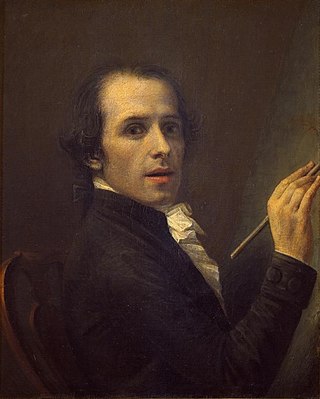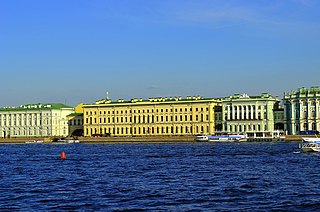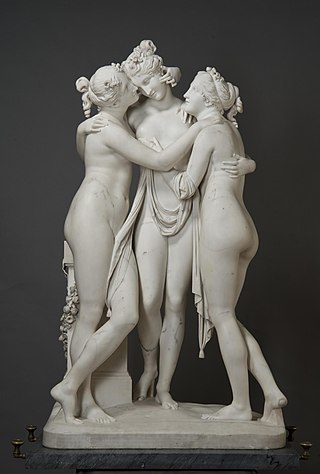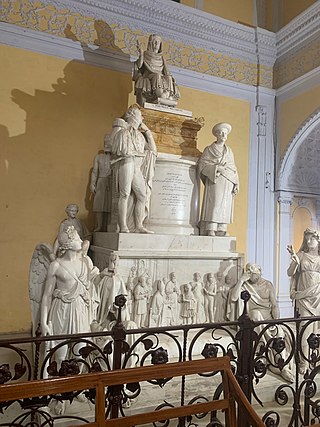
The Penitent Magdalene is a marble sculpture of Mary Magdalene by Antonio Canova, about 90 cm high, known in two final versions, now in Genoa and St Petersburg.

The Penitent Magdalene is a marble sculpture of Mary Magdalene by Antonio Canova, about 90 cm high, known in two final versions, now in Genoa and St Petersburg.
The difficulties in elaborating the theme had led Canova to produce two very different preparatory works. The original version of 1793-1796 was praised at the Salon of 1808, the first of Canova's works to be a success there. [1] It was acquired by the French commissar Juliot and in 1808 passed into the hands of the Milanese collector Comte Masseo conte Giovanni Battista Sommariva and, after his death, to signor d'Aguado. [2] It was acquired by Raffaele de Ferrari, Duca di Galliera and displayed in his palace in Paris, before being left to the collection of the city of Genoa in 1889 by his wife Maria Brignole-Sale de Ferrari - it is now in the Palazzo Doria-Tursi, part of the Strada Nuova Museums in Genoa.
Canova also produced another version between 1808 and 1809 for Eugène de Beauharnais, viceroy of Italy, who exhibited it in his palace in Munich. [2] The initial preparatory work showed the head raised and the arms crossed, but in the final 1808-1809 work the head are lowered and the hands holding a gilded bronze cross, though that is missing in the 1808-1809 version, either subsequently lost or more likely since mixed-medium sculptures were not accepted in France at that time.
This version remained in the collection of the de Beauharnais' successors as Duke of Leuchtenberg and thus moved to St Petersburg, passing to Soviet Russia's State Museum Fund and finally in 1922 to the Hermitage Museum, where it remains. [3]

Antonio Canova was an Italian Neoclassical sculptor, famous for his marble sculptures. Often regarded as the greatest of the Neoclassical artists, his sculpture was inspired by the Baroque and the classical revival, and has been characterised as having avoided the melodramatics of the former, and the cold artificiality of the latter.

Joséphine Bonaparte was Empress of the French as the first wife of Emperor Napoleon I from 18 May 1804 until their marriage was annulled on 10 January 1810. As Napoleon's consort, she was also Queen of Italy from 26 May 1805 until the 1810 annulment. She is widely known as Joséphine de Beauharnais.

The State Hermitage Museum is a museum of art and culture in Saint Petersburg, Russia. It was founded in 1764 when Empress Catherine the Great acquired a collection of paintings from the Berlin merchant Johann Ernst Gotzkowsky. The museum celebrates the anniversary of its founding each year on 7 December, Saint Catherine's Day. It has been open to the public since 1852. The Art Newspaper ranked the museum 10th in their list of the most visited art museums, with 2,812,913 visitors in 2022.

Giuseppe Bossi was an Italian painter, arts administrator and writer on art. He ranks among the foremost figures of Neoclassical culture in Lombardy, along with Ugo Foscolo, Giuseppe Parini, Andrea Appiani or Manzoni.

Antonio Canova's statue The Three Graces is a Neoclassical sculpture, in marble, of the mythological three Charites, daughters of Zeus – identified on some engravings of the statue as, from left to right, Euphrosyne, Aglaea and Thalia – who were said to represent youth/beauty (Thalia), mirth (Euphrosyne), and elegance (Aglaea). The Graces presided over banquets and gatherings, to delight the guests of the gods. As such they have served as subjects for historical artists including Sandro Botticelli and Bertel Thorvaldsen. A version of the sculpture is in the Hermitage Museum, and another is owned jointly and exhibited in turn by the Victoria and Albert Museum, Scottish National Gallery while another one is in Galerie Plastik in Hořice.

Leo von Klenze was a German architect and painter. He was the court architect of Ludwig I of Bavaria.

Possagno is a comune in the Province of Treviso, in the Italian region Veneto. It is located about 60 kilometres (37 mi) northwest of Venice and about 35 kilometres (22 mi) northwest of Treviso. As of 31 August 2021, it had a population of 2,215 and an area of 12.1 square kilometres (4.7 sq mi).

Pauline Bonaparte as Venus Victrix is a semi-nude life-size reclining neo-Classical portrait sculpture by the Italian sculptor Antonio Canova. Reviving the ancient Roman artistic traditions of portrayals of mortal individuals in the guise of the gods, and of the beautiful female form reclining on a couch, it was commissioned by Pauline Bonaparte's husband Camillo Borghese and executed in Rome from 1805 to 1808, after the subject's marriage into the Borghese family. It then moved to Camillo's house in Turin, then to Genoa, only arriving in its present home around 1838.

The Mond Crucifixion or Gavari Altarpiece is an oil on poplar panel dated to 1502–1503, making it one of the earliest works by Italian Renaissance artist Raphael, perhaps the second after the c.1499-1500 Baronci Altarpiece. It originally comprised four elements, of which three survive, now all separated: a main panel of the Crucified Christ with the Virgin Mary, Saints and Angels which was bequeathed to the National Gallery, London, by Ludwig Mond, and a three-panel predella from which one panel is lost; the two surviving panels are Eusebius of Cremona raising Three Men from the Dead with Saint Jerome's Cloak in the Museu Nacional de Arte Antiga, in Lisbon, and Saint Jerome saving Silvanus and punishing the Heretic Sabinianus in the North Carolina Museum of Art.

Psyche Revived by Cupid's Kiss is a sculpture by Italian artist Antonio Canova first commissioned in 1787 by Colonel John Campbell. It is regarded as a masterpiece of Neoclassical sculpture, but shows the mythological lovers at a moment of great emotion, characteristic of the emerging movement of Romanticism. It represents the god Cupid in the height of love and tenderness, immediately after awakening the lifeless Psyche with a kiss. The story of Cupid and Psyche is taken from Lucius Apuleius' Latin novel The Golden Ass, and was popular in art.

Domenico Piola was a Genoese painter of the Baroque period. He was the leading artist in Genoa in the second half of the 17th century, working on ceiling frescoes for many Genoese churches and palaces and canvas paintings for private collectors. His family studio was highly prolific and frequently collaborated with other artists.

Giampietrino, probably Giovanni Pietro Rizzoli, was a north Italian painter of the Lombard school and Leonardo's circle, succinctly characterized by S. J. Freedberg as an "exploiter of Leonardo's repertory."

Villa Carlotta is a villa and botanical garden in Tremezzo on Lake Como in Northern Italy. Today the villa is a museum, whose collection includes works by sculptors such as Antonio Canova, Bertel Thorvaldsen, and Giovanni Migliara; painters such as Francesco Hayez; and furniture pieces of previous owners. The villa, whose architect is unknown, was completed in 1745.

The Palazzo Brignole Sale or Palazzo Rosso is a house museum located in Via Garibaldi, in the historical center of Genoa, in Northwestern Italy. The palace is part of the UNESCO World Heritage Site Genoa: Le Strade Nuove and the system of the Palazzi dei Rolli. The rich art collection inside, along with the galleries of Palazzo Bianco and Palazzo Doria Tursi, is part of the Musei di Strada Nuova and consists of the works of artists of the caliber of Antoon van Dyck, Guido Reni, Paolo Veronese, Guercino, Gregorio De Ferrari, Albrecht Dürer, Bernardo Strozzi and Mattia Preti.

Napoleon as Mars the Peacemaker is a colossal heroic nude statue by the Italian artist Antonio Canova, of Napoleon I of France in the guise of the Roman god Mars. He holds a gilded Nike or Victory standing on an orb in his right hand and a staff in his left. It was produced between 1802 and 1806 and stands 3.45 metres to the raised left hand. Once on display in the Louvre in Paris, it was purchased from Louis XVIII in 1816 by the British government, which granted it to the Duke of Wellington. It is now on display in Robert Adam's stairwell at the Duke's London residence, Apsley House.

The Galleria d'Arte Moderna is a modern art museum in Milan, in Lombardy in northern Italy. It is housed in the Villa Reale, at Via Palestro 16, opposite the Giardini Pubblici Indro Montanelli. The collection consists largely of Italian and European works from the eighteenth to the twentieth centuries.

Adamo Tadolini was an Italian sculptor. One of a family of sculptors, he studied in Rome with the neo-classical sculptor Antonio Canova and is linked to him in style.

The Musei di Strada Nuova in the Italian city of Genoa comprise three museums which together form a single complex, housed in the Palazzo Rosso, the Palazzo Bianco and the Palazzo Tursi, all of which are located along the Via Garibaldi. The Palazzo Tursi is also Genoa's city hall.

The Dead Christ Mourned is an oil painting on canvas of c. 1604 by Annibale Carracci. It was in the Orleans Collection before arriving in Great Britain in 1798. In 1913 it was donated to the National Gallery, London, which describes it as "perhaps the most poignant image in [its] collection of the pietà – the lamentation over the dead Christ following his crucifixion – and one of the greatest expressions of grief in Baroque art".